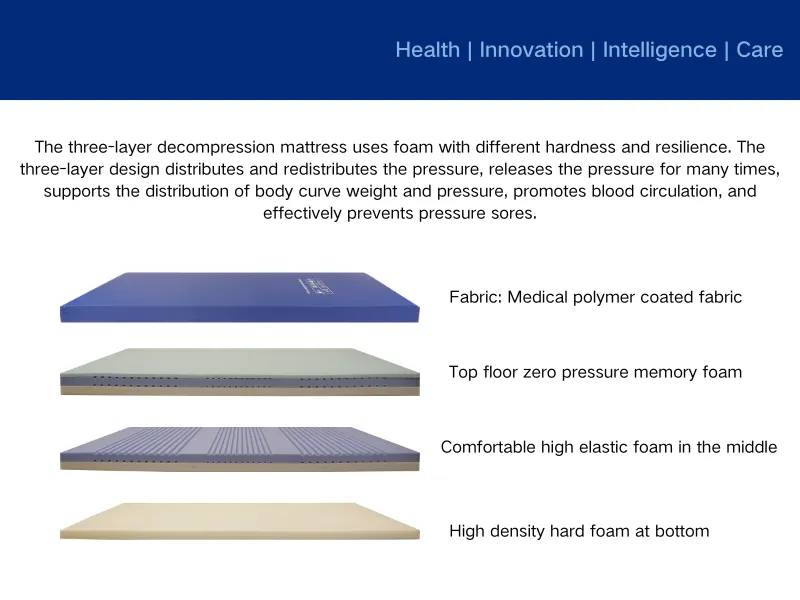The Therapeutic Impact of Pressure Relieving Mattresses on Stage I and Stage II Pressure Ulcers
Pressure ulcers, commonly referred to as bedsores or pressure injuries, are localized damage to the skin and underlying tissue resulting from prolonged pressure, shear forces, or friction. These wounds predominantly affect individuals with limited mobility, such as elderly patients, those with spinal cord injuries, or individuals recovering from prolonged hospitalization. Stage I and Stage II pressure ulcers represent the earliest and most manageable forms of these injuries, where timely intervention can prevent progression into more severe and life-threatening conditions.

How a Pressure Relief Mattress Works: Mechanisms of Action
- Pressure Redistribution: The Core Principle
The primary function of a pressure relief mattress is to distribute body weight evenly, preventing excessive pressure on any single point. Standard mattresses often create high-pressure zones over bony areas, leading to tissue hypoxia and necrosis. In contrast, pressure relieving mattresses utilize advanced materials (such as viscoelastic foam, air cells, or gel matrices) to disperse pressure dynamically or statically.
Static Pressure Redistribution: Foam-based or gel-infused mattresses conform to the body’s contours, continuously cushioning high-risk areas.
Dynamic Pressure Redistribution: Alternating air mattresses periodically inflate and deflate different sections, ensuring no single area endures prolonged compression.
- Microclimate Control: Managing Heat and Moisture
Excessive moisture and heat exacerbate skin breakdown, particularly in immobile patients. Many pressure ulcer prevention mattresses incorporate breathable covers and moisture-wicking fabrics to regulate temperature and humidity. Some advanced models feature low-air-loss (LAL) systems that circulate air to keep the skin dry, reducing maceration and bacterial growth.
- Shear and Friction Reduction
Shear forces occur when layers of tissue slide against each other (e.g., when a patient is dragged across a bed), while friction results from skin rubbing against bedding. Both factors contribute to ulcer formation. A mattress to relieve pressure points minimizes these risks by providing a stable, low-friction surface that moves with the patient rather than against them.
- Enhanced Blood Circulation and Tissue Oxygenation
By alleviating pressure, these mattresses restore blood flow to compressed tissues, facilitating oxygen and nutrient delivery—a critical factor in healing Stage I and II ulcers. Improved circulation also aids in removing metabolic waste products that accumulate in ischemic tissues.
Selecting the Right Pressure Relieving Mattress
Not all pressure relieving mattresses are created equal. The choice depends on the patient’s condition, mobility level, and ulcer severity.
- Foam-Based Pressure Relief Mattresses
Best for: Stage I ulcers or low-risk patients.
Features: High-density memory foam that conforms to body shape, providing continuous pressure redistribution.
Advantages: Cost-effective, low maintenance, and suitable for home use.
- Alternating Pressure Mattresses
Best for: Stage II ulcers or high-risk patients.
Features: Air cells that alternately inflate and deflate to shift pressure points dynamically.
Advantages: Highly effective in preventing and treating ulcers, ideal for immobile patients.
- Low-Air-Loss (LAL) and Air-Fluidized Mattresses
Best for: Patients with excessive moisture or those at risk of infection.
Features: Airflow systems that keep the skin dry while providing pressure relief.
Advantages: Excellent for managing exudating wounds and preventing maceration.
- Hybrid Mattresses (Foam + Air Technology)
Best for: Patients requiring a balance of comfort and therapeutic support.
Features: Combines foam cushioning with dynamic air adjustments.
Advantages: Versatile, suitable for both prevention and treatment.
For patients with Stage I and II pressure ulcers, a pressure relieving mattress is not merely a comfort aid—it is a medical necessity. By effectively redistributing pressure, enhancing blood flow, and creating an optimal healing environment, these mattresses play a crucial role in both prevention and treatment.
-
Sleep Tracking Mattress Maintenance TipsニュースJul.22,2025
-
Mattress Wave Designs for People with ArthritisニュースJul.22,2025
-
Mattress for Back Pain and Spinal AlignmentニュースJul.22,2025
-
Hypoallergenic Properties of Silicone Gel MattressニュースJul.22,2025
-
How a Gel Memory Foam Mattress Regulates TemperatureニュースJul.22,2025
-
Doctors’ Recommendations on Special Mattress for Back PainニュースJul.22,2025
-
Customizing a Patient Bed Mattress for Specific NeedsニュースJul.22,2025

